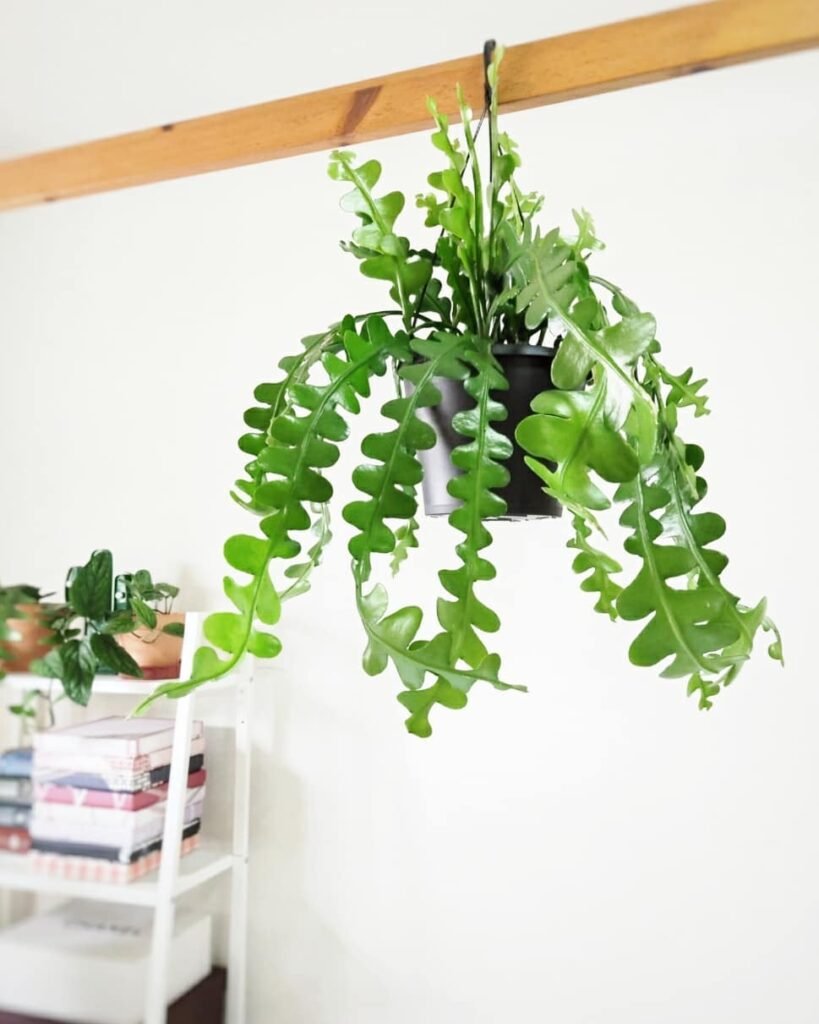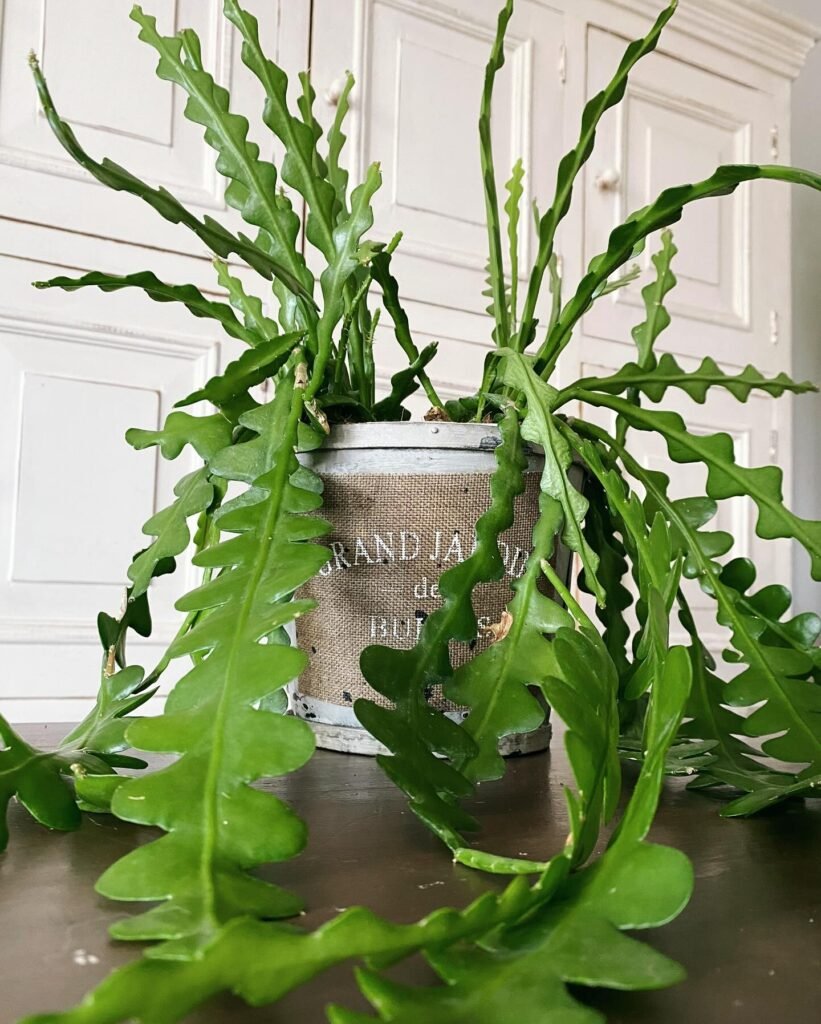Let me tell you a story about how I discovered the beauty of the Selenicereus anthonyanus, also known as the fishbone cactus. One day, while browsing a local plant nursery, a bright display caught my eye. Amongst the array of green foliage, there it was – a fishbone cactus, with its long, flattened stems resembling intricate fishbones. Instantly captivated by its unique appearance, I knew I had to bring it home.
Excitedly, I researched about the care tips for this extraordinary plant. From propagation to soil requirements, pruning to sunlight needs, I delved into the world of Selenicereus anthonyanus care. Now, I want to share the knowledge I’ve gained with you, so that you too can experience the joy of caring for this remarkable indoor plant in the UK.
In this article, I will provide you with practical advice on how to care for your fishbone cactus, ensuring it thrives and blooms beautifully. Whether you’re a seasoned plant enthusiast or just starting your green journey, I’m here to guide you through the wonderful world of Selenicereus anthonyanus care. Let’s dive in and unlock the secrets to caring for this stunning plant!
What is a Fishbone Cactus?


The fishbone cactus, also known as the ric rac cactus or zig zag cactus, gets its name from the unique appearance of its flattened stems, which resemble fishbones. Some growers also refer to it as the orchid cactus due to its beautiful, orchid-like flowers. The leaves of the fishbone cactus have an undulating margin with lobes, giving them a distinct fishbone shape. This plant is a climber in its native habitat, with each leaf capable of growing up to 8 to 12 feet long.
Fishbone cacti, also known as tropical cacti, are not tolerant of frost, making them unsuitable for outdoor cultivation in the UK climate. However, they thrive as houseplants and can be enjoyed indoors year-round. If you wish to move your fishbone cactus outdoors during the summer months, ensure to bring it back indoors as autumn approaches, as temperatures below 40°F are detrimental to their well-being.
These tropical cacti appreciate moist and humid environments, making them well-suited for indoor cultivation. Their hardiness in the UK climate allows enthusiasts to enjoy their unique beauty and stunning fishbone-like stems year-round, regardless of the unpredictable weather conditions outdoors.
 Did you know the Selenicereus anthonyanus, commonly known as the Fishbone Cactus, blooms only at night? Its stunning flowers are a rare treat, opening after sundown and closing by morning, adapted to be pollinated by nocturnal creatures. Truly a spectacular night-time show in your own home!
Did you know the Selenicereus anthonyanus, commonly known as the Fishbone Cactus, blooms only at night? Its stunning flowers are a rare treat, opening after sundown and closing by morning, adapted to be pollinated by nocturnal creatures. Truly a spectacular night-time show in your own home!
The best light for a Fishbone Cactus indoors


When growing fishbone cacti indoors, it is important to provide them with bright, indirect light. Direct sunlight can cause the leaves to bleach out and become pale in color. Placing them near an east or west-facing window or in a bright, sunny room with semi-bright indirect light for a few hours in the morning or late afternoon/evening is ideal.

How to water a Ric Rac Cactus


Watering the fishbone cactus is simple. To ensure its well-being, it’s essential to strike the right balance between underwatering and overwatering. Here are some watering tips:
- Allow the potting soil to dry out completely between waterings. The fishbone cactus prefers slightly drier conditions, so ensure the top inch of soil is dry before watering again.
- Thoroughly water the plant until water drains out of the bottom of the pot. This ensures complete hydration and helps prevent waterlogged soil.
- Depending on the environment and humidity levels, aim to water the fishbone cactus approximately every 10 days.
- Observe the leaves for signs of dryness. If the leaves start to show signs of dehydration or curling, it’s time to water.
Remember, the fishbone cactus is tolerant of both underwatering and overwatering, making it adaptable to varying watering schedules. By allowing the soil to dry out and providing thorough hydration, you’ll maintain the optimal soil moisture for your fishbone cactus to thrive.

Fertilizing a Fishbone Cactus


The fishbone cactus, like any other plant, benefits from regular fertilization to support healthy growth and vibrant blooms. Here are some essential tips for fertilizing your fishbone cactus:
1. Choose the right fertilizer
When selecting a fertilizer for your fishbone cactus, opt for an organic water-soluble fertilizer or a granular houseplant fertilizer. These types of fertilizers provide essential nutrients while being gentle on the plant.
2. Follow a feeding schedule
During the active growing season, typically in spring and summer, feed your fishbone cactus every 6 to 8 weeks. This ensures a steady supply of nutrients to support healthy foliage and promote flowering.
3. Consider a bloom-boosting fertilizer
If you want to encourage abundant blooms on your fishbone cactus, use a fertilizer slightly higher in potassium. Apply this bloom-boosting fertilizer for three consecutive applications once a year. Orchid fertilizers or African violet fertilizers work well for this purpose.
4. Apply the fertilizer properly
Follow the instructions on the fertilizer packaging for the correct dilution ratio or application rate. Remember that it’s always better to under-fertilize than over-fertilize, as excessive fertilizer can lead to nutrient burn and harm the plant.
5. Water before and after fertilizing
Before applying fertilizer, water your fishbone cactus thoroughly to ensure the soil is well-moistened. This helps prevent fertilizer burn. After fertilizing, give the plant another gentle watering to help distribute the nutrients evenly.
6. Monitor for signs of overfeeding
Keep an eye on your fishbone cactus for any signs of overfeeding, such as leaf discoloration, scorching, or wilting. If you notice any of these symptoms, reduce the frequency or strength of the fertilizer application.
By following these fertilizing tips, you can provide your fishbone cactus with the nutrients it needs to thrive and produce stunning blooms. Remember to adjust the feeding schedule based on the specific needs of your plant, and always prioritize the well-being of your fishbone cactus.

Fishbone Cactus propagation


If you’re looking to expand your collection of fishbone cacti or share these beautiful plants with friends and family, propagation is a simple and effective method. There are two main methods of fishbone cactus propagation: stem cuttings and leaf cuttings.
For stem cuttings, select a healthy stem from the parent plant and make a clean cut just below a leaf node. Remove any lower leaves to expose the node. The cutting can be rooted directly in soil or placed in water until roots develop. No rooting hormone is necessary for this process. Keep the soil moist or change the water regularly, and within a few weeks, you should see new root growth.
- Choose a healthy stem.
- Make a clean cut below a leaf node.
- Remove lower leaves to expose the node.
- Root the cutting in soil or water.
- Maintain moisture and wait for root growth.
Leaf cuttings can also be used for propagation. Simply select a healthy leaf and cut it close to the stem. Insert the cut end directly into the soil, ensuring it is securely planted. Water regularly to maintain moisture, and within a few weeks, roots should begin to develop.
- Select a healthy leaf.
- Cut the leaf close to the stem.
- Insert the cut end directly into the soil.
- Keep the soil consistently moist.
- Wait for root growth to occur.
Whether you choose stem cuttings or leaf cuttings, the key to successful fishbone cactus propagation is regular watering and consistent moisture. Remember to be patient as it may take a few weeks for roots to develop. With the proper care and attention, you can enjoy the rewarding experience of watching your fishbone cactus plant grow and thrive.

Other plant care tips


When it comes to caring for your fishbone cactus, there are a few additional tips to keep in mind to ensure its health and well-being.
Pruning
While regular pruning is not necessary for fishbone cacti, you may occasionally find that your plant has become too large or needs some shaping. If that is the case, you can trim away any excess growth using sterilized pruning shears. This will help maintain a neat and compact appearance.
Plant Maintenance
In addition to pruning, it’s important to keep up with regular plant maintenance. This includes removing any dead or yellowing leaves to promote overall plant health. It’s also a good idea to wipe the leaves with a damp cloth from time to time to remove dust and keep them looking their best.
Draft Prevention
During the winter months, it’s important to protect your fishbone cactus from drafts. Avoid placing it near cold windows or frequently opened doors, as the sudden changes in temperature can be harmful to the plant. Find a cozy spot away from drafts to keep your cactus happy and healthy.
Avoid Forced Air Heat
Fishbone cacti thrive in moist, humid environments. Therefore, it’s best to keep them away from forced air heat registers, as the warm, dry air can be detrimental to their humidity-loving nature. Opt for placing your plant in a location where it can enjoy consistent humidity levels without the drying effects of forced air heat.
By following these fishbone cactus care tips, you can ensure that your plant remains healthy and vibrant year-round. With proper pruning, regular maintenance, and attention to draft prevention and heat sources, your fishbone cactus will thrive in its indoor environment.

How to get the humidity just right
Fishbone cacti, with their origins in the lush tropical rainforests, thrive in moist and humid conditions. Although they can adapt to lower humidity levels, providing the right amount of humidity will help ensure their health and vitality. Here are some simple tips to help you maintain the ideal humidity for your fishbone cactus:
- Consistent Soil Moisture: Focus on keeping the soil consistently moist but not waterlogged. This will help create a naturally humid microenvironment around the plant’s roots and stems.
- Bathroom Placement: Placing your fishbone cactus in a bathroom with a window can provide a naturally humid environment due to steam from showers and baths. The moisture in the air will benefit your plant.
- Pebble Tray: Consider using a pebble tray beneath the pot. Simply fill a tray with water and place pebbles or stones on top. Make sure the water level does not touch the bottom of the pot. As the water evaporates, it will increase the humidity around the plant.
With these simple steps, you can create a conducive environment for your fishbone cactus to thrive. Remember, while higher humidity levels are preferred, the plant can adapt to lower levels as long as the soil moisture remains consistent.
 Interestingly, the Selenicereus anthonyanus, or Fishbone Cactus, doesn’t require direct sunlight to thrive. This makes it an exceptional choice for indoor spaces with limited natural light, a splendid adaptation for growing in the shaded understorey of tropical forests.
Interestingly, the Selenicereus anthonyanus, or Fishbone Cactus, doesn’t require direct sunlight to thrive. This makes it an exceptional choice for indoor spaces with limited natural light, a splendid adaptation for growing in the shaded understorey of tropical forests.
Repotting Tips
Repotting your fishbone cactus is an essential part of its care routine. I recommend repotting every 3 to 4 years or when the plant outgrows its current pot. This allows for healthy root growth and ensures the cactus has enough space to thrive.
When selecting a new pot, choose one that is 1 to 2 inches larger in diameter than the previous pot. This extra space will accommodate the growing roots and provide room for the plant to flourish. Opt for a well-draining potting mix, like a blend of cacti-specific potting mix and compost. This mixture helps retain moisture while allowing excess water to drain away, preventing root rot.
When it comes to repotting, timing is everything. The ideal time to repot your fishbone cactus is in the spring or summer, during its active growing season. This ensures that the plant has sufficient time to adjust to its new surroundings and minimizes any stress it may experience. Take care not to disturb the delicate roots during the repotting process, and gently tamp down the soil around the base of the plant to provide stability.
By following these repotting tips and providing your fishbone cactus with the right pot size and potting mix, you can promote healthy root growth and overall plant well-being. Remember to repot every few years to give your fishbone cactus the space it needs to thrive and continue to bring beauty to your indoor space.
Common pests
Fishbone cacti are generally trouble-free, but occasionally, they can fall victim to common pests, such as mealybugs. These small, fuzzy white insects tend to infest the plant, especially when it is kept outdoors during the summer months. However, there are effective pest control methods to combat this issue.
One simple method is to wipe the affected leaves with a cotton pad soaked in rubbing alcohol. The alcohol helps to remove the mealybugs and prevent further infestation. Alternatively, you can use a cotton swab dipped in a mixture of soapy water to remove the pests.
If the infestation is severe, you may need to escalate the treatment by using horticultural oil or insecticidal soap. These products are designed to target and eliminate mealybugs, ensuring the health and wellbeing of your fishbone cactus.
Helpful Videos about Selenicereus anthonyanus (Fishbone Cactus)
Check out these brilliant videos I’ve found on caring for the Fishbone Cactus, also known as Selenicereus anthonyanus. They’re packed with simple tips to help you easily look after this unique plant. Ideal for gardening newcomers, these guides will give you the confidence to start nurturing your own Fishbone Cactus straight away. A great pick for those new to the world of plants!
- Fish Bone Cactus (Selenicereus anthonyanus) / Showy, fragrant Purple Flowers / Fast growing epiphyte
- FISHBONE CACTUS
FAQ about Selenicereus anthonyanus (Fishbone Cactus)

Keen to master caring for your Selenicereus anthonyanus, lovingly known as the Fishbone Cactus? You’ve hit the jackpot! I’ve put together the must-know questions to make looking after this cactus a breeze. Whether you’re puzzled about the watering schedule or dealing with specific challenges, you’re all set.
Selenicereus anthonyanus, also known as the Fishbone Cactus or Ric Rac Cactus, is a stunning, epiphytic cactus with unique, wavy, fishbone-patterned leaves. It’s known for its ease of care and striking appearance.
The Fishbone Cactus thrives in bright, indirect sunlight. Direct sunlight can scorch its leaves, so a spot that receives filtered light is ideal, especially in the strong UK summer sun.
Water when the top inch of soil feels dry to the touch. In the UK climate, this usually means watering less frequently in winter to prevent root rot.
Yes, a well-draining potting mix suited for cacti or succulents is best, as it prevents water from pooling around the roots.
Choose a pot only slightly larger than the current one and repot in spring. Carefully transfer your cactus, ensuring the root system is not disturbed.
Yes, with proper care and enough light, the Fishbone Cactus can produce beautiful, fragrant flowers even in the UK climate.
Ensure it gets enough indirect light and consider a low-nitrogen, high-phosphorus fertiliser during the growing season to encourage blooms.
The Fishbone Cactus prefers temperatures between 18°C and 25°C. Protect it from cold draughts and frost, which are common in the UK.
Cut a piece of the stem, let it callous over for a few days, then plant it in moist, well-draining soil. It should root in a few weeks.
No, the Fishbone Cactus is non-toxic to pets, making it a great choice for households with curious animals.
Feed with a diluted cactus fertiliser every 4-6 weeks during the growing season (spring and summer).
In summer, yes, but ensure it’s in a sheltered spot with indirect light. Move it indoors before the temperature drops in autumn.
Keep an eye out for common pests like mealybugs. Wipe them off with a cotton bud dipped in alcohol or use an appropriate insecticide.
Drooping can result from under-watering, over-watering, or lack of nutrients. Check the soil and adjust your care as needed.
While it prefers bright, indirect light, it can tolerate lower light conditions better than many cacti. However, growth may be slower, and flowering less likely in low light.
If you suspect root rot, immediately repot your cactus into fresh, well-draining soil and a clean pot, removing any mushy or blackened roots. Ensure proper drainage and adjust your watering schedule.
Before the UK’s autumn chill sets in, usually by late September or early October. Nighttime temperatures dropping consistently below 10°C are a good indicator.
I trust this FAQ has shed some light on how to nurture your Selenicereus anthonyanus, also fondly known as the Fishbone Cactus. Should you have further queries, feel free to pop them in the comments below. I’m here to assist. Bear in mind, we all begin our plant journey with zero knowledge, and there’s always a fresh insight to gain as you journey alongside your unique plant pal.





